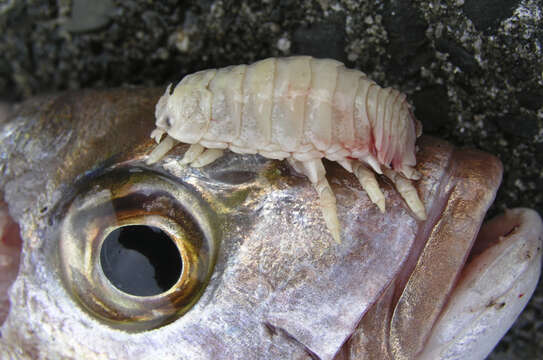Tongue-eating-louse on Snapper

Description:
I caught a snapper off the rocks on Rangitoto Island and when I had landed it, this creature crawled out of it's mouth. I happened to have my camera with me - I was nearly gagging watching it.Cymothoa exigua, or the tongue-eating louse, is a parasitic crustacean of the family Cymothoidae. It tends to be 3 to 4 centimetres (1.2 to 1.6 in) long. This parasite enters through the gills, and then attaches itself at the base of the spotted rose snapper's (Lutjanus guttatus) tongue. It extracts blood through the claws on its front, causing the tongue to atrophy from lack of blood. The parasite then replaces the fish's tongue by attaching its own body to the muscles of the tongue stub. The fish is able to use the parasite just like a normal tongue. It appears that the parasite does not cause any other damage to the host fish. Once C. exigua replaces the tongue, some feed on the host's blood and many others feed on fish mucus. This is the only known case of a parasite functionally replacing a host organ. It is currently believed that C. exigua are not harmful to humans unless picked up alive, in which case they can bite.Imagine if Cockroaches crawled into your mouth at night and attached itself to your tongue.www.propartganda.comandy@haumoana.com
Included On The Following Pages:
- Life (creatures)
- Cellular (cellular organisms)
- Eukaryota (eukaryotes)
- Opisthokonta (opisthokonts)
- Metazoa (Animal)
- Bilateria
- Protostomia (protostomes)
- Ecdysozoa (ecdysozoans)
- Arthropoda (arthropods)
- Pancrustacea
- Multicrustacea (typical crustaceans)
- Malacostraca (malacostracans)
- Eumalacostraca
- Peracarida (peracarids)
- Isopoda (isopods)
- Cymothoida
- Cymothooidea
- Cymothoidae (tongue biters)
- Cymothoa
- Cymothoa exigua (Tongue-Eating Isopod)
This image is not featured in any collections.
Source Information
- license
- cc-by-nc-sa
- copyright
- Andy Heyward
- photographer
- Andy Heyward
- original
- original media file
- visit source
- partner site
- Flickr Group
- ID


